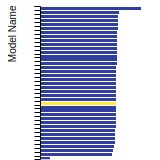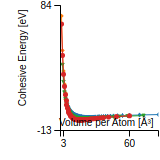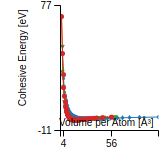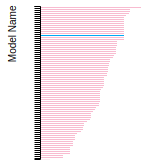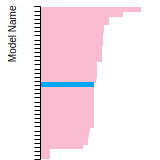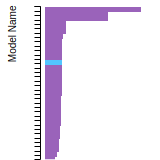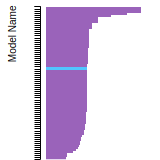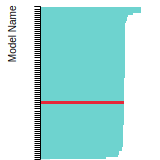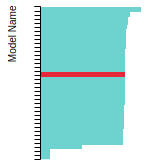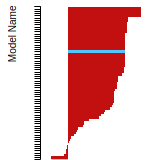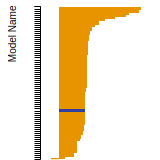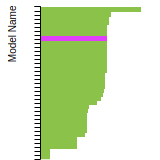 MEAM_LAMMPS_KimKimJung_2016_AlTi__MO_618133763375_002
MEAM_LAMMPS_KimKimJung_2016_AlTi__MO_618133763375_002
| Title
A single sentence description.
|
MEAM Potential for the Al-Ti system developed by Kim et al. (2016) v002 |
|---|---|
| Description
A short description of the Model describing its key features including for example: type of model (pair potential, 3-body potential, EAM, etc.), modeled species (Ac, Ag, ..., Zr), intended purpose, origin, and so on.
|
An interatomic potential for the Ti–Al binary system has been developed based on the second nearest-neighbor modified embedded-atom method (2NN MEAM) formalism. This potential describes fundamental materials properties (structural, thermodynamic, elastic, defect, deformation and thermal properties) of Ti–Al alloys in good agreements with experimental or first-principles data. |
| Species
The supported atomic species.
| Al, Ti |
| Disclaimer
A statement of applicability provided by the contributor, informing users of the intended use of this KIM Item.
|
None |
| Content Origin | http://cmse.postech.ac.kr/home_2nnmeam |
| Contributor |
Sang-Ho Oh |
| Maintainer |
Sang-Ho Oh |
| Developer |
Young-Kwang Kim Hong-Kyu Kim Woo-Sang Jung Byeong-Joo Lee |
| Published on KIM | 2023 |
| How to Cite |
This Model originally published in [1] is archived in OpenKIM [2-5]. [1] Kim Y-K, Kim H-K, Jung W-S, Lee B-J. Atomistic modeling of the Ti–Al binary system. Computational materials science. 2016;119:1–8. doi:10.1016/j.commatsci.2016.03.038 — (Primary Source) A primary source is a reference directly related to the item documenting its development, as opposed to other sources that are provided as background information. [2] Kim Y-K, Kim H-K, Jung W-S, Lee B-J. MEAM Potential for the Al-Ti system developed by Kim et al. (2016) v002. OpenKIM; 2023. doi:10.25950/522a8fbb [3] Afshar Y, Hütter S, Rudd RE, Stukowski A, Tipton WW, Trinkle DR, et al. The modified embedded atom method (MEAM) potential v002. OpenKIM; 2023. doi:10.25950/ee5eba52 [4] Tadmor EB, Elliott RS, Sethna JP, Miller RE, Becker CA. The potential of atomistic simulations and the Knowledgebase of Interatomic Models. JOM. 2011;63(7):17. doi:10.1007/s11837-011-0102-6 [5] Elliott RS, Tadmor EB. Knowledgebase of Interatomic Models (KIM) Application Programming Interface (API). OpenKIM; 2011. doi:10.25950/ff8f563a Click here to download the above citation in BibTeX format. |
| Citations
This panel presents information regarding the papers that have cited the interatomic potential (IP) whose page you are on. The OpenKIM machine learning based Deep Citation framework is used to determine whether the citing article actually used the IP in computations (denoted by "USED") or only provides it as a background citation (denoted by "NOT USED"). For more details on Deep Citation and how to work with this panel, click the documentation link at the top of the panel. The word cloud to the right is generated from the abstracts of IP principle source(s) (given below in "How to Cite") and the citing articles that were determined to have used the IP in order to provide users with a quick sense of the types of physical phenomena to which this IP is applied. The bar chart shows the number of articles that cited the IP per year. Each bar is divided into green (articles that USED the IP) and blue (articles that did NOT USE the IP). Users are encouraged to correct Deep Citation errors in determination by clicking the speech icon next to a citing article and providing updated information. This will be integrated into the next Deep Citation learning cycle, which occurs on a regular basis. OpenKIM acknowledges the support of the Allen Institute for AI through the Semantic Scholar project for providing citation information and full text of articles when available, which are used to train the Deep Citation ML algorithm. |
This panel provides information on past usage of this interatomic potential (IP) powered by the OpenKIM Deep Citation framework. The word cloud indicates typical applications of the potential. The bar chart shows citations per year of this IP (bars are divided into articles that used the IP (green) and those that did not (blue)). The complete list of articles that cited this IP is provided below along with the Deep Citation determination on usage. See the Deep Citation documentation for more information. 
42 Citations (35 used)
Help us to determine which of the papers that cite this potential actually used it to perform calculations. If you know, click the .
USED (high confidence) F. Zhao, J. Zhang, C. He, Y. Zhang, X. Gao, and L. Xie, “Molecular Dynamics Simulation on Creep Behavior of Nanocrystalline TiAl Alloy,” Nanomaterials. 2020. link Times cited: 10 Abstract: TiAl alloy represents a new class of light and heat-resistan… read more USED (high confidence) N. Walker, K.-M. Tam, B. R. Novak, and M. Jarrell, “Identifying structural changes with unsupervised machine learning methods,” Physical Review E. 2018. link Times cited: 8 Abstract: Unsupervised machine learning methods are used to identify s… read more USED (high confidence) S. Sun, B. Ramachandran, and C. Wick, “Solid, liquid, and interfacial properties of TiAl alloys: parameterization of a new modified embedded atom method model,” Journal of Physics: Condensed Matter. 2018. link Times cited: 11 Abstract: New interatomic potentials for pure Ti and Al, and binary Ti… read more USED (high confidence) A. Moradi, A. Heidari, K. Amini, F. Aghadavoudi, and R. Abedinzadeh, “Molecular modeling of Ti-6Al-4V alloy shot peening: the effects of diameter and velocity of shot particles and force field on mechanical properties and residual stress,” Modelling and Simulation in Materials Science and Engineering. 2021. link Times cited: 12 Abstract: Shot peening is a surface treatment process that is used for… read more USED (high confidence) J. Raush, “Thermophysical and Thermochemical Property Measurement and Prediction of Liquid Metal Titanium Alloys with Applications in Additive Manufacturing.” 2016. link Times cited: 0 Abstract: ............................................................… read more USED (low confidence) R. Xiao, K. L. Liu, Y. Ruan, and B. Wei, “Rapid acquisition of liquid thermophysical properties from pure metals to quaternary alloys by proposing a machine learning strategy,” Applied Physics Letters. 2023. link Times cited: 2 Abstract: The establishment of reliable materials genome databases inv… read more USED (low confidence) T. Li, C. Tian, A. Moridi, and J. Yeo, “Elucidating Interfacial Dynamics of Ti-Al Systems Using Molecular Dynamics Simulation and Markov State Modeling,” ACS applied materials & interfaces. 2023. link Times cited: 0 Abstract: Due to their remarkable mechanical and chemical properties, … read more USED (low confidence) J. Lu, J. Wang, K. Wan, Y. Chen, H. Wang, and X. Shi, “An accurate interatomic potential for the TiAlNb ternary alloy developed by deep neural network learning method.,” The Journal of chemical physics. 2023. link Times cited: 0 Abstract: The complex phase diagram and bonding nature of the TiAl sys… read more USED (low confidence) J.-yao Liu and L. Zhang, “Investigation on the Diffusion Behaviors and Mechanical Properties of the Ti/Al Interface Using Molecular Dynamics Simulation,” Journal of Materials Engineering and Performance. 2023. link Times cited: 0 USED (low confidence) G. Poletaev, Y. Bebikhov, A. S. Semenov, and A. Sitnikov, “Molecular Dynamics Investigation of the Effect of the Interface Orientation on the Intensity of Titanium Dissolution in Crystalline and Amorphous Aluminum,” Journal of Experimental and Theoretical Physics. 2023. link Times cited: 0 USED (low confidence) K. A. Nair and S. Ghosh, “Crack tip enhanced phase-field model for crack evolution in crystalline Ti6Al from concurrent crystal plasticity FE-molecular dynamics simulations,” European Journal of Mechanics - A/Solids. 2023. link Times cited: 1 USED (low confidence) B. Zhai and H. P. Wang, “Accurate interatomic potential for the nucleation in liquid Ti-Al binary alloy developed by deep neural network learning method,” Computational Materials Science. 2023. link Times cited: 2 USED (low confidence) B. Waters, D. S. Karls, I. Nikiforov, R. Elliott, E. Tadmor, and B. Runnels, “Automated determination of grain boundary energy and potential-dependence using the OpenKIM framework,” Computational Materials Science. 2022. link Times cited: 5 USED (low confidence) N. Dhariwal, A. S. M. Miraz, W. Meng, and C. Wick, “Strengthening the Ti/Tin Interface Against Shear Failure with Al Dopants:A Molecular Dynamics Study,” SSRN Electronic Journal. 2022. link Times cited: 1 USED (low confidence) R. Fereidonnejad, A. O. Moghaddam, and M. Moaddeli, “Modified embedded-atom method interatomic potentials for Al-Ti, Al-Ta, Al-Zr, Al-Nb and Al-Hf binary intermetallic systems,” Computational Materials Science. 2022. link Times cited: 5 USED (low confidence) B. Zhai, Q. Wang, J. Chang, and H. Wang, “Primary Phase Selection Related to Liquid Local Structure Within Ti–Al–V Alloy Solidified During Free Fall,” Metallurgical and Materials Transactions B. 2022. link Times cited: 1 USED (low confidence) G. Poletaev, Y. Bebikhov, and A. Semenov, “The Effect of Ti–Al Interfacial Orientation and Ti Deformation on the Interdiffusion Rate at Temperatures above the Melting Point of Al: A Molecular-Dynamics Study,” Technical Physics Letters. 2022. link Times cited: 0 USED (low confidence) G. Poletaev, A. Sitnikov, V. Yakovlev, and V. Filimonov, “Melting Point of Ti, Ti3Al, TiAl, and TiAl3 Nanoparticles Versus Their Diameter in Vacuum and Liquid Aluminum: Molecular Dynamics Investigation,” Journal of Experimental and Theoretical Physics. 2022. link Times cited: 1 USED (low confidence) S. Attarian and S. Xiao, “Development of a 2NN-MEAM potential for Ti B system and studies of the temperature dependence of the nanohardness of TiB2,” Computational Materials Science. 2022. link Times cited: 3 USED (low confidence) H. Xiang and W. Guo, “A newly developed interatomic potential of Nb−Al−Ti ternary systems for high-temperature applications,” Acta Mechanica Sinica. 2022. link Times cited: 5 USED (low confidence) G. Poletaev, Y. Bebikhov, A. Semenov, and M. Starostenkov, “Self-diffusion in melts of Ni-Al and Ti-Al systems: molecular dynamics study,” Letters on Materials. 2021. link Times cited: 3 Abstract: Self-diffusion in liquid alloys of Ni-Al and Ti-Al systems, … read more USED (low confidence) J.-yao Liu and L. Zhang, “Molecular Dynamics Simulation of the Tensile Deformation Behavior of the γ(TiAl)/α2(Ti3Al) Interface at Different Temperatures,” Journal of Materials Engineering and Performance. 2021. link Times cited: 3 USED (low confidence) G. Poletaev, “Self-Diffusion in Liquid and Solid Alloys of the Ti–Al System: Molecular Dynamics Simulation,” Journal of Experimental and Theoretical Physics. 2021. link Times cited: 6 USED (low confidence) Y. Yang, M. Liu, S. Zhou, W. Ren, Q. Zhou, and S. Lan, “Breaking through the strength-ductility trade-off in graphene reinforced Ti6Al4V composites,” Journal of Alloys and Compounds. 2021. link Times cited: 22 USED (low confidence) G. Poletaev, A. Sitnikov, and V. Filimonov, “Melting temperature of Ti and TiAl nanoparticles in vacuum and in Al matrix depending on their diameter: molecular dynamics study,” Letters on Materials. 2021. link Times cited: 2 Abstract: The dependence of the melting temperature of Ti and TiAl nan… read more USED (low confidence) Q. Pei, M. Jhon, S. Quek, and Z. Wu, “A systematic study of interatomic potentials for mechanical behaviours of Ti-Al alloys,” Computational Materials Science. 2021. link Times cited: 19 USED (low confidence) S. Wang, F. Xie, X.-qing Wu, T. Lv, and Y. Ma, “Microstructure and high temperature oxidation behavior of the Al2O3 CPED coating on TiAl alloy,” Journal of Alloys and Compounds. 2020. link Times cited: 24 USED (low confidence) R. Voskoboinikov, “An insight into radiation resistance of D019 Ti3Al intermetallics,” Journal of Nuclear Materials. 2019. link Times cited: 15 USED (low confidence) M. Elkhateeb and Y. Shin, “Molecular dynamics-based cohesive zone representation of Ti6Al4V/TiC composite interface,” Materials & Design. 2018. link Times cited: 43 USED (low confidence) P. Liu, X. Han, D. Sun, and Q. Wang, “Development and application of a ternary Ti-Al-N interatomic potential for Ti2AlN/TiAl composite,” Journal of Alloys and Compounds. 2018. link Times cited: 20 USED (low confidence) Y.-K. Kim, H. Kim, W. Jung, and B.-J. Lee, “Development and application of Ni-Ti and Ni-Al-Ti 2NN-MEAM interatomic potentials for Ni-base superalloys,” Computational Materials Science. 2017. link Times cited: 24 USED (low confidence) C.-jun Wu, B.-J. Lee, and X. Su, “Modified embedded-atom interatomic potential for Fe-Ni, Cr-Ni and Fe-Cr-Ni systems,” Calphad-computer Coupling of Phase Diagrams and Thermochemistry. 2017. link Times cited: 60 USED (low confidence) S. Y. Korostelev, E. E. Slyadnikov, and I. Turchanovsky, “The resistance of amorphous metals to thermal effects. Molecular dynamics modeling,” PHYSICAL MESOMECHANICS OF CONDENSED MATTER: Physical Principles of Multiscale Structure Formation and the Mechanisms of Nonlinear Behavior: MESO2022. 2023. link Times cited: 0 USED (low confidence) A. I. Dmitriev, A. Nikonov, and A. R. Shugurov, “Molecular dynamics study of the strength properties of TixAl1-xN coatings,” PHYSICAL MESOMECHANICS OF CONDENSED MATTER: Physical Principles of Multiscale Structure Formation and the Mechanisms of Nonlinear Behavior: MESO2022. 2023. link Times cited: 0 USED (low confidence) Y. Jian, Z. Huang, J. Xing, L. Sun, Y. Liu, and P. Gao, “Phase stability, mechanical properties and electronic structures of Ti Al binary compounds by first principles calculations,” Materials Chemistry and Physics. 2019. link Times cited: 47 NOT USED (high confidence) H. Ganesan, I. Scheider, and C. Cyron, “Quantifying the High-Temperature Separation Behavior of Lamellar Interfaces in γ-Titanium Aluminide Under Tensile Loading by Molecular Dynamics,” Frontiers in Materials. 2021. link Times cited: 4 Abstract: γ-titanium aluminide (TiAl) alloys with fully lamellar micro… read more NOT USED (high confidence) Z. Yin et al., “Phase stability, brittle-ductile transition, and electronic structures of the TiAl alloying with Fe, Ru, Ge, and Sn: a first-principle investigation,” Journal of Molecular Modeling. 2020. link Times cited: 5 NOT USED (high confidence) J. Kundu, A. Chakraborty, and S. Kundu, “Bonding pressure effects on characteristics of microstructure, mechanical properties, and mass diffusivity of Ti-6Al-4V and TiAlNb diffusion-bonded joints,” Welding in the World. 2020. link Times cited: 3 NOT USED (high confidence) N. Pushilina, V. Kudiiarov, M. Syrtanov, and E. Kashkarov, “Effect of the Beam Current during the Electron-Beam Melting of Titanium Alloy Ti–6Al–4V on the Structural Features and Phase Transitions in Gas-Phase Hydrogenation,” Journal of Surface Investigation: X-ray, Synchrotron and Neutron Techniques. 2019. link Times cited: 3 NOT USED (high confidence) D. Dickel, C. Barrett, R. Cariño, M. Baskes, and M. Horstemeyer, “Mechanical instabilities in the modeling of phase transitions of titanium,” Modelling and Simulation in Materials Science and Engineering. 2018. link Times cited: 16 Abstract: In this paper, we demonstrate that previously observed β to … read more NOT USED (high confidence) N. Pushilina et al., “Hydrogen-Induced Phase Transformation and Microstructure Evolution for Ti-6Al-4V Parts Produced by Electron Beam Melting.” 2018. link Times cited: 37 Abstract: In this paper, phase transitions and microstructure evolutio… read more NOT USED (high confidence) M. Wang, W.-xian Wang, H. Chen, and Y. Li, “Understanding micro-diffusion bonding from the fabrication of B4C/Ni composites,” International Journal of Minerals, Metallurgy, and Materials. 2018. link Times cited: 7 |
| Funding | Not available |
| Short KIM ID
The unique KIM identifier code.
| MO_618133763375_002 |
| Extended KIM ID
The long form of the KIM ID including a human readable prefix (100 characters max), two underscores, and the Short KIM ID. Extended KIM IDs can only contain alpha-numeric characters (letters and digits) and underscores and must begin with a letter.
| MEAM_LAMMPS_KimKimJung_2016_AlTi__MO_618133763375_002 |
| DOI |
10.25950/522a8fbb https://doi.org/10.25950/522a8fbb https://commons.datacite.org/doi.org/10.25950/522a8fbb |
| KIM Item Type
Specifies whether this is a Portable Model (software implementation of an interatomic model); Portable Model with parameter file (parameter file to be read in by a Model Driver); Model Driver (software implementation of an interatomic model that reads in parameters).
| Portable Model using Model Driver MEAM_LAMMPS__MD_249792265679_002 |
| Driver | MEAM_LAMMPS__MD_249792265679_002 |
| KIM API Version | 2.2 |
| Potential Type | meam |
| Previous Version | MEAM_LAMMPS_KimKimJung_2016_AlTi__MO_618133763375_001 |
| Grade | Name | Category | Brief Description | Full Results | Aux File(s) |
|---|---|---|---|---|---|
| P | vc-species-supported-as-stated | mandatory | The model supports all species it claims to support; see full description. |
Results | Files |
| P | vc-periodicity-support | mandatory | Periodic boundary conditions are handled correctly; see full description. |
Results | Files |
| P | vc-permutation-symmetry | mandatory | Total energy and forces are unchanged when swapping atoms of the same species; see full description. |
Results | Files |
| B | vc-forces-numerical-derivative | consistency | Forces computed by the model agree with numerical derivatives of the energy; see full description. |
Results | Files |
| N/A | vc-dimer-continuity-c1 | informational | The energy versus separation relation of a pair of atoms is C1 continuous (i.e. the function and its first derivative are continuous); see full description. |
Results | Files |
| P | vc-objectivity | informational | Total energy is unchanged and forces transform correctly under rigid-body translation and rotation; see full description. |
Results | Files |
| P | vc-inversion-symmetry | informational | Total energy is unchanged and forces change sign when inverting a configuration through the origin; see full description. |
Results | Files |
| N/A | vc-memory-leak | informational | The model code does not have memory leaks (i.e. it releases all allocated memory at the end); see full description. |
Results | Files |
| P | vc-thread-safe | mandatory | The model returns the same energy and forces when computed in serial and when using parallel threads for a set of configurations. Note that this is not a guarantee of thread safety; see full description. |
Results | Files |
| P | vc-unit-conversion | mandatory | The model is able to correctly convert its energy and/or forces to different unit sets; see full description. |
Results | Files |
BCC Lattice Constant
This bar chart plot shows the mono-atomic body-centered cubic (bcc) lattice constant predicted by the current model (shown in the unique color) compared with the predictions for all other models in the OpenKIM Repository that support the species. The vertical bars show the average and standard deviation (one sigma) bounds for all model predictions. Graphs are generated for each species supported by the model.
Cohesive Energy Graph
This graph shows the cohesive energy versus volume-per-atom for the current mode for four mono-atomic cubic phases (body-centered cubic (bcc), face-centered cubic (fcc), simple cubic (sc), and diamond). The curve with the lowest minimum is the ground state of the crystal if stable. (The crystal structure is enforced in these calculations, so the phase may not be stable.) Graphs are generated for each species supported by the model.
Diamond Lattice Constant
This bar chart plot shows the mono-atomic face-centered diamond lattice constant predicted by the current model (shown in the unique color) compared with the predictions for all other models in the OpenKIM Repository that support the species. The vertical bars show the average and standard deviation (one sigma) bounds for all model predictions. Graphs are generated for each species supported by the model.
Dislocation Core Energies
This graph shows the dislocation core energy of a cubic crystal at zero temperature and pressure for a specific set of dislocation core cutoff radii. After obtaining the total energy of the system from conjugate gradient minimizations, non-singular, isotropic and anisotropic elasticity are applied to obtain the dislocation core energy for each of these supercells with different dipole distances. Graphs are generated for each species supported by the model.
(No matching species)FCC Elastic Constants
This bar chart plot shows the mono-atomic face-centered cubic (fcc) elastic constants predicted by the current model (shown in blue) compared with the predictions for all other models in the OpenKIM Repository that support the species. The vertical bars show the average and standard deviation (one sigma) bounds for all model predictions. Graphs are generated for each species supported by the model.
FCC Lattice Constant
This bar chart plot shows the mono-atomic face-centered cubic (fcc) lattice constant predicted by the current model (shown in red) compared with the predictions for all other models in the OpenKIM Repository that support the species. The vertical bars show the average and standard deviation (one sigma) bounds for all model predictions. Graphs are generated for each species supported by the model.
FCC Stacking Fault Energies
This bar chart plot shows the intrinsic and extrinsic stacking fault energies as well as the unstable stacking and unstable twinning energies for face-centered cubic (fcc) predicted by the current model (shown in blue) compared with the predictions for all other models in the OpenKIM Repository that support the species. The vertical bars show the average and standard deviation (one sigma) bounds for all model predictions. Graphs are generated for each species supported by the model.
FCC Surface Energies
This bar chart plot shows the mono-atomic face-centered cubic (fcc) relaxed surface energies predicted by the current model (shown in blue) compared with the predictions for all other models in the OpenKIM Repository that support the species. The vertical bars show the average and standard deviation (one sigma) bounds for all model predictions. Graphs are generated for each species supported by the model.
SC Lattice Constant
This bar chart plot shows the mono-atomic simple cubic (sc) lattice constant predicted by the current model (shown in the unique color) compared with the predictions for all other models in the OpenKIM Repository that support the species. The vertical bars show the average and standard deviation (one sigma) bounds for all model predictions. Graphs are generated for each species supported by the model.
Cubic Crystal Basic Properties Table
Species: AlSpecies: Ti
Creators:
Contributor: karls
Publication Year: 2019
DOI: https://doi.org/10.25950/64cb38c5
This Test Driver uses LAMMPS to compute the cohesive energy of a given monoatomic cubic lattice (fcc, bcc, sc, or diamond) at a variety of lattice spacings. The lattice spacings range from a_min (=a_min_frac*a_0) to a_max (=a_max_frac*a_0) where a_0, a_min_frac, and a_max_frac are read from stdin (a_0 is typically approximately equal to the equilibrium lattice constant). The precise scaling and number of lattice spacings sampled between a_min and a_0 (a_0 and a_max) is specified by two additional parameters passed from stdin: N_lower and samplespacing_lower (N_upper and samplespacing_upper). Please see README.txt for further details.
| Test | Test Results | Link to Test Results page | Benchmark time
Usertime multiplied by the Whetstone Benchmark. This number can be used (approximately) to compare the performance of different models independently of the architecture on which the test was run.
Measured in Millions of Whetstone Instructions (MWI) |
|---|---|---|---|
| Cohesive energy versus lattice constant curve for bcc Al v004 | view | 6258 | |
| Cohesive energy versus lattice constant curve for bcc Ti v004 | view | 6184 | |
| Cohesive energy versus lattice constant curve for diamond Al v004 | view | 5928 | |
| Cohesive energy versus lattice constant curve for diamond Ti v004 | view | 6405 | |
| Cohesive energy versus lattice constant curve for fcc Al v004 | view | 5610 | |
| Cohesive energy versus lattice constant curve for fcc Ti v004 | view | 6047 | |
| Cohesive energy versus lattice constant curve for sc Al v004 | view | 6296 | |
| Cohesive energy versus lattice constant curve for sc Ti v004 | view | 5890 |
Creators: Junhao Li and Ellad Tadmor
Contributor: tadmor
Publication Year: 2019
DOI: https://doi.org/10.25950/5853fb8f
Computes the cubic elastic constants for some common crystal types (fcc, bcc, sc, diamond) by calculating the hessian of the energy density with respect to strain. An estimate of the error associated with the numerical differentiation performed is reported.
| Test | Test Results | Link to Test Results page | Benchmark time
Usertime multiplied by the Whetstone Benchmark. This number can be used (approximately) to compare the performance of different models independently of the architecture on which the test was run.
Measured in Millions of Whetstone Instructions (MWI) |
|---|---|---|---|
| Elastic constants for bcc Al at zero temperature v006 | view | 18042 | |
| Elastic constants for bcc Ti at zero temperature v006 | view | 18111 | |
| Elastic constants for diamond Al at zero temperature v001 | view | 48516 | |
| Elastic constants for fcc Al at zero temperature v006 | view | 17843 | |
| Elastic constants for fcc Ti at zero temperature v006 | view | 34493 | |
| Elastic constants for sc Al at zero temperature v006 | view | 19216 | |
| Elastic constants for sc Ti at zero temperature v006 | view | 19554 |
Creators:
Contributor: ilia
Publication Year: 2024
DOI: https://doi.org/10.25950/2f2c4ad3
Computes the equilibrium crystal structure and energy for an arbitrary crystal at zero temperature and applied stress by performing symmetry-constrained relaxation. The crystal structure is specified using the AFLOW prototype designation. Multiple sets of free parameters corresponding to the crystal prototype may be specified as initial guesses for structure optimization. No guarantee is made regarding the stability of computed equilibria, nor that any are the ground state.
Creators:
Contributor: ilia
Publication Year: 2025
DOI: https://doi.org/10.25950/866c7cfa
Computes the equilibrium crystal structure and energy for an arbitrary crystal at zero temperature and applied stress by performing symmetry-constrained relaxation. The crystal structure is specified using the AFLOW prototype designation. Multiple sets of free parameters corresponding to the crystal prototype may be specified as initial guesses for structure optimization. No guarantee is made regarding the stability of computed equilibria, nor that any are the ground state.
| Test | Test Results | Link to Test Results page | Benchmark time
Usertime multiplied by the Whetstone Benchmark. This number can be used (approximately) to compare the performance of different models independently of the architecture on which the test was run.
Measured in Millions of Whetstone Instructions (MWI) |
|---|---|---|---|
| Equilibrium crystal structure and energy for Al in AFLOW crystal prototype A_cF4_225_a v003 | view | 146189 | |
| Equilibrium crystal structure and energy for Ti in AFLOW crystal prototype A_cF4_225_a v003 | view | 177756 | |
| Equilibrium crystal structure and energy for Al in AFLOW crystal prototype A_cI2_229_a v003 | view | 198814 | |
| Equilibrium crystal structure and energy for Ti in AFLOW crystal prototype A_cI2_229_a v003 | view | 149044 | |
| Equilibrium crystal structure and energy for Ti in AFLOW crystal prototype A_hP2_194_c v003 | view | 146432 | |
| Equilibrium crystal structure and energy for Ti in AFLOW crystal prototype A_hP3_191_ad v003 | view | 174393 |
Creators:
Contributor: brunnels
Publication Year: 2022
DOI: https://doi.org/10.25950/2c59c9d6
Computes grain boundary energy for a range of tilt angles given a crystal structure, tilt axis, and material.
| Test | Test Results | Link to Test Results page | Benchmark time
Usertime multiplied by the Whetstone Benchmark. This number can be used (approximately) to compare the performance of different models independently of the architecture on which the test was run.
Measured in Millions of Whetstone Instructions (MWI) |
|---|---|---|---|
| Relaxed energy as a function of tilt angle for a 100 symmetric tilt grain boundary in fcc Al v003 | view | 22397010 | |
| Relaxed energy as a function of tilt angle for a 110 symmetric tilt grain boundary in fcc Al v001 | view | 69186872 |
Creators: Daniel S. Karls and Junhao Li
Contributor: karls
Publication Year: 2019
DOI: https://doi.org/10.25950/2765e3bf
Equilibrium lattice constant and cohesive energy of a cubic lattice at zero temperature and pressure.
| Test | Test Results | Link to Test Results page | Benchmark time
Usertime multiplied by the Whetstone Benchmark. This number can be used (approximately) to compare the performance of different models independently of the architecture on which the test was run.
Measured in Millions of Whetstone Instructions (MWI) |
|---|---|---|---|
| Equilibrium zero-temperature lattice constant for bcc Al v007 | view | 14133 | |
| Equilibrium zero-temperature lattice constant for bcc Ti v007 | view | 11779 | |
| Equilibrium zero-temperature lattice constant for diamond Al v007 | view | 13546 | |
| Equilibrium zero-temperature lattice constant for diamond Ti v007 | view | 14829 | |
| Equilibrium zero-temperature lattice constant for fcc Al v007 | view | 12663 | |
| Equilibrium zero-temperature lattice constant for fcc Ti v007 | view | 13914 | |
| Equilibrium zero-temperature lattice constant for sc Al v007 | view | 11558 | |
| Equilibrium zero-temperature lattice constant for sc Ti v007 | view | 12957 |
Creators:
Contributor: mjwen
Publication Year: 2024
DOI: https://doi.org/10.25950/9d9822ec
This Test Driver uses LAMMPS to compute the linear thermal expansion coefficient at a finite temperature under a given pressure for a cubic lattice (fcc, bcc, sc, diamond) of a single given species.
| Test | Test Results | Link to Test Results page | Benchmark time
Usertime multiplied by the Whetstone Benchmark. This number can be used (approximately) to compare the performance of different models independently of the architecture on which the test was run.
Measured in Millions of Whetstone Instructions (MWI) |
|---|---|---|---|
| Linear thermal expansion coefficient of fcc Al at 293.15 K under a pressure of 0 MPa v002 | view | 3411674 |
Creators: Matt Bierbaum
Contributor: mattbierbaum
Publication Year: 2019
DOI: https://doi.org/10.25950/64f4999b
Calculates the phonon dispersion relations for fcc lattices and records the results as curves.
| Test | Test Results | Link to Test Results page | Benchmark time
Usertime multiplied by the Whetstone Benchmark. This number can be used (approximately) to compare the performance of different models independently of the architecture on which the test was run.
Measured in Millions of Whetstone Instructions (MWI) |
|---|---|---|---|
| Phonon dispersion relations for fcc Al v004 | view | 113523 |
Creators:
Contributor: SubrahmanyamPattamatta
Publication Year: 2019
DOI: https://doi.org/10.25950/b4cfaf9a
Intrinsic and extrinsic stacking fault energies, unstable stacking fault energy, unstable twinning energy, stacking fault energy as a function of fractional displacement, and gamma surface for a monoatomic FCC lattice at zero temperature and pressure.
| Test | Test Results | Link to Test Results page | Benchmark time
Usertime multiplied by the Whetstone Benchmark. This number can be used (approximately) to compare the performance of different models independently of the architecture on which the test was run.
Measured in Millions of Whetstone Instructions (MWI) |
|---|---|---|---|
| Stacking and twinning fault energies for fcc Al v002 | view | 42527250 |
Creators: Matt Bierbaum
Contributor: mattbierbaum
Publication Year: 2019
DOI: https://doi.org/10.25950/6c43a4e6
Calculates the surface energy of several high symmetry surfaces and produces a broken-bond model fit. In latex form, the fit equations are given by:
E_{FCC} (\vec{n}) = p_1 (4 \left( |x+y| + |x-y| + |x+z| + |x-z| + |z+y| +|z-y|\right)) + p_2 (8 \left( |x| + |y| + |z|\right)) + p_3 (2 ( |x+ 2y + z| + |x+2y-z| + |x-2y + z| + |x-2y-z| + |2x+y+z| + |2x+y-z| +|2x-y+z| +|2x-y-z| +|x+y+2z| +|x+y-2z| +|x-y+2z| +|x-y-2z| ) + c
E_{BCC} (\vec{n}) = p_1 (6 \left( | x+y+z| + |x+y-z| + |-x+y-z| + |x-y+z| \right)) + p_2 (8 \left( |x| + |y| + |z|\right)) + p_3 (4 \left( |x+y| + |x-y| + |x+z| + |x-z| + |z+y| +|z-y|\right)) +c.
In Python, these two fits take the following form:
def BrokenBondFCC(params, index):
import numpy
x, y, z = index
x = x / numpy.sqrt(x**2.+y**2.+z**2.)
y = y / numpy.sqrt(x**2.+y**2.+z**2.)
z = z / numpy.sqrt(x**2.+y**2.+z**2.)
return params[0]*4* (abs(x+y) + abs(x-y) + abs(x+z) + abs(x-z) + abs(z+y) + abs(z-y)) + params[1]*8*(abs(x) + abs(y) + abs(z)) + params[2]*(abs(x+2*y+z) + abs(x+2*y-z) +abs(x-2*y+z) +abs(x-2*y-z) + abs(2*x+y+z) +abs(2*x+y-z) +abs(2*x-y+z) +abs(2*x-y-z) + abs(x+y+2*z) +abs(x+y-2*z) +abs(x-y+2*z) +abs(x-y-2*z))+params[3]
def BrokenBondBCC(params, x, y, z):
import numpy
x, y, z = index
x = x / numpy.sqrt(x**2.+y**2.+z**2.)
y = y / numpy.sqrt(x**2.+y**2.+z**2.)
z = z / numpy.sqrt(x**2.+y**2.+z**2.)
return params[0]*6*(abs(x+y+z) + abs(x-y-z) + abs(x-y+z) + abs(x+y-z)) + params[1]*8*(abs(x) + abs(y) + abs(z)) + params[2]*4* (abs(x+y) + abs(x-y) + abs(x+z) + abs(x-z) + abs(z+y) + abs(z-y)) + params[3]
| Test | Test Results | Link to Test Results page | Benchmark time
Usertime multiplied by the Whetstone Benchmark. This number can be used (approximately) to compare the performance of different models independently of the architecture on which the test was run.
Measured in Millions of Whetstone Instructions (MWI) |
|---|---|---|---|
| Broken-bond fit of high-symmetry surface energies in fcc Al v004 | view | 136718 |
Creators:
Contributor: efuem
Publication Year: 2023
DOI: https://doi.org/10.25950/fca89cea
Computes the monovacancy formation energy and relaxation volume for cubic and hcp monoatomic crystals.
| Test | Test Results | Link to Test Results page | Benchmark time
Usertime multiplied by the Whetstone Benchmark. This number can be used (approximately) to compare the performance of different models independently of the architecture on which the test was run.
Measured in Millions of Whetstone Instructions (MWI) |
|---|---|---|---|
| Monovacancy formation energy and relaxation volume for fcc Al | view | 560252 |
Creators:
Contributor: efuem
Publication Year: 2023
DOI: https://doi.org/10.25950/c27ba3cd
Computes the monovacancy formation and migration energies for cubic and hcp monoatomic crystals.
| Test | Test Results | Link to Test Results page | Benchmark time
Usertime multiplied by the Whetstone Benchmark. This number can be used (approximately) to compare the performance of different models independently of the architecture on which the test was run.
Measured in Millions of Whetstone Instructions (MWI) |
|---|---|---|---|
| Vacancy formation and migration energy for fcc Al | view | 887569 |
| Test | Error Categories | Link to Error page |
|---|---|---|
| Elastic constants for diamond Ti at zero temperature v001 | other | view |
EquilibriumCrystalStructure__TD_457028483760_000
| Test | Error Categories | Link to Error page |
|---|---|---|
| Equilibrium crystal structure and energy for AlTi in AFLOW crystal prototype AB_tP2_123_a_d v000 | other | view |
GrainBoundaryCubicCrystalSymmetricTiltRelaxedEnergyVsAngle__TD_410381120771_003
| Test | Error Categories | Link to Error page |
|---|---|---|
| Relaxed energy as a function of tilt angle for a 111 symmetric tilt grain boundary in fcc Al v001 | other | view |
| Relaxed energy as a function of tilt angle for a 112 symmetric tilt grain boundary in fcc Al v001 | other | view |
LatticeConstantHexagonalEnergy__TD_942334626465_005
| Test | Error Categories | Link to Error page |
|---|---|---|
| Equilibrium lattice constants for hcp Al v005 | other | view |
| Equilibrium lattice constants for hcp Ti v005 | other | view |
LinearThermalExpansionCoeffCubic__TD_522633393614_001
| Test | Error Categories | Link to Error page |
|---|---|---|
| Linear thermal expansion coefficient of fcc Al at 293.15 K under a pressure of 0 MPa v001 | other | view |
PhononDispersionCurve__TD_530195868545_004
| Test | Error Categories | Link to Error page |
|---|---|---|
| Phonon dispersion relations for fcc Al v004 | other | view |
SurfaceEnergyCubicCrystalBrokenBondFit__TD_955413365818_004
| Test | Error Categories | Link to Error page |
|---|---|---|
| Broken-bond fit of high-symmetry surface energies in fcc Al v004 | other | view |
No Driver
| Verification Check | Error Categories | Link to Error page |
|---|---|---|
| DimerContinuityC1__VC_303890932454_005 | other | view |
| MEAM_LAMMPS_KimKimJung_2016_AlTi__MO_618133763375_002.txz | Tar+XZ | Linux and OS X archive |
| MEAM_LAMMPS_KimKimJung_2016_AlTi__MO_618133763375_002.zip | Zip | Windows archive |
This Model requires a Model Driver. Archives for the Model Driver MEAM_LAMMPS__MD_249792265679_002 appear below.
| MEAM_LAMMPS__MD_249792265679_002.txz | Tar+XZ | Linux and OS X archive |
| MEAM_LAMMPS__MD_249792265679_002.zip | Zip | Windows archive |
